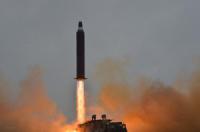-
Hamas develops powerful new rockets, threatening Israeli towns near Gaza
The Palestinian terrorist group Hamas has acquired new, more powerful rockets that could severely threaten Israeli towns near the Gaza Strip. The rockets carry hundreds of kilograms of explosive material and have a short range of a few kilometers, similar to the range of mortar shells, according to an assessment by the Israeli military. While the Iron Dome anti-missile system can shoot down short-range projectiles, it is not as effective against mortar shells and rockets with more limited ranges.
-
-
NSF-funded research continues to support national security
The National Science Foundation (NSF) is usually associated with supporting scientists who go on to win Nobel Prizes, leading exploration of the planet’s polar regions, and enabling discoveries about the universe, from the subatomic world to distant galaxies. But the foundation also has ties to national defense that go back to its beginnings, as a product of the U.S. government working to enhance security during and after the Second World War. The National Science Foundation Act of 1950 called for the creation of an agency to “promote the progress of science; to advance the national health, prosperity, and welfare; and to secure the national defense.” NSF’s founder, Vannevar Bush, said: “It has become clear beyond all doubt that scientific research is absolutely essential to national security.”
-
-
Israel plans mass evacuations in case of war With Hamas, Hezbollah
In case of a future war with the Islamist terrorist groups Hamas or Hezbollah, Israel would completely evacuate its border communities — up to 250,000 people in either case — to lower the threat level, news reports say. These evacuations, coordinated with local municipalities to keep civilians safe, would be the biggest in Israeli history.
-
-
In first, Israel’s Arrow-3 system intercepts Syrian missile fired at Israeli jet
Israel’s Arrow-3 system successfully intercepted a Syrian anti-aircraft missile that was shot at Israeli jets conducting a mission in Syria on Thursday night, the Israel Defense Forces said in a statement. It is the first time that the Arrow-3 system is known to have been used operationally.
-
-
Missiles tested by North Korean this weekend capable of carrying 500 kg warhead to 1,000 km

Over the weekend, North Korea launched four ballistic missiles into the Sea of Japan. The missiles reportedly traveled an average of 1,000 km (620 miles), and landed within 300 to 350 km (185 to 220 miles) of Japan. The four launches were said to be “simultaneous,” leading to speculation they were intended to be a barrage attack to overwhelm a missile defense system. The missiles appear to be Extended-Range Scud (“Scud ER”) missiles, which are modifications of short-range Scud missiles, lengthened to carry additional fuel and lightened by making the body out of aluminum rather than the usual steel. Analysis suggests the missile could carry a warhead of roughly 500 kg to 1,000 km.
-
-
Increase in arms transfers driven by demand in the Middle East, Asia
The volume of international transfers of major weapons has grown continuously since 2004 and increased by 8.4 percent between 2007–11 and 2012–16, according to new data on arms transfers published today by the Stockholm International Peace Research Institute (SIPRI). Notably, transfers of major weapons in 2012–16 reached their highest volume for any five-year period since the end of the cold war.
-
-
Russia violates landmark arms-control treaty by secretly deploying banned cruise missile

The Trump administration may be facing its first challenge from Russia as news emerged that Russia had secretly deployed a new cruise missile. The development and deployment of the cruise missile violates a landmark arms control treaty, signed in 1987 – the Intermediate-Range Nuclear Forces Treaty (INF Treaty) — which prohibited the development and deployment by the United States and Russia of land-based intermediate-range missiles.
-
-
Israel prepares for possible Hezbollah naval commando attack
The Israel Defense Forces (IDF) is preparing for a possible Hezbollah incursion using marines and other naval commandos in the country’s north. A group of commandos could try to infiltrate north of Nahariya while protected by mortar and anti-tank fire from Lebanon, the IDF believes. It also believes that Hezbollah will attempt to capture Israeli territory and hold it, even temporarily, in order to declare a victory against Israel.
-
-
SideArm prototype catches full-size drones flying at full speed
Few scenes capture the U.S. Navy’s prowess as effectively as the rapid-fire takeoff and recovery of combat jets from the deck of an aircraft carrier. The ability to carry air power anywhere in the world, and both launch those aircraft to flight speed and bring them to a stop over extremely short distances, has been essential to carriers’ decades-long dominance of naval warfare. To help provide similar capabilities—minus the 90,000-ton carriers—to U.S. military units around the world, DARPA’s SideArm research effort seeks to create a self-contained, portable apparatus able to horizontally launch and retrieve unmanned aerial systems (UASs) of up to 900 pounds. The self-contained, portable apparatus can be used to launch and retrieve unmanned aircraft from trucks, ships, and fixed bases.
-
-
Should we really be so afraid of a nuclear North Korea?
The common thinking is that North Korea’s nuclear program poses a threat to global peace and diverts economic resources from an impoverished population. North Korean leaders are depicted in the Western media as a cabal of madmen who won’t be satisfied until Washington, Seoul, or some other enemy city is turned into a “sea of fire.” But it also pays to consider what sounds like a perverse question: could a North Korean bomb actually benefit both the country’s people and the world at large? As far as Pyongyang is concerned, its militaristic strategy has worked: It has kept the Kim government internally stable, the population dependent on the government, and the country’s enemies at bay. Accepting the country’s nuclear status, rather than trying to head it off with sanctions and threats, could bring it back to the diplomatic bargaining table.
-
-
Helping Marines make faster, better combat decisions
Battlefield commanders face many scenarios requiring fast decisions — attacking an enemy position, evacuating injured warfighters, navigating unfamiliar terrain. Each situation pushes leaders to make quick yet informed choices. To enhance these decision-making capabilities, especially for small-unit leaders, the 2nd Battalion, 6th Marines (2/6) — “The Spartans” — recently held a weeklong exercise called Spartan Emerging Technology and Innovation Week at Camp Lejeune, North Carolina. The event featured various training technologies to accelerate the development of decision-making skills.
-
-
NATO must more firmly counter Russia's cyber-weaponry: U.K defense minister
NATO must begin to compete on the cyber-battlefield to counter Russian hacking aimed at undermining democracy in the United States and Western Europe, the British defense secretary, Sir Michael Fallon, has said in a speech earlier today (Thursday, 2 February) at St. Andrews University, one of the main centers for Russian studies in the United Kingdom. In his harshest and most pointed criticism yet of Russia, he accused Moscow of targeting the United States, France, Germany, Holland, Bulgaria, and Montenegro.
-
-
Report: German intelligence believes Iran tested nuclear-capable cruise missile
In addition to a ballistic missile test that Iran itself revealed, Germany believes that Iran also test-fired a Sumar cruise missile, which could have a range of 2,000-3,000 kilometers (1,250-1,875 miles) and could reach Germany at its maximum capability. In its test, the Sumar successfully traveled 600 kilometers (375 miles), a little less than half the distance to Israel.
-
-
U.S. warns Iran about ballistic missile test
Michael Flynn, President Donald Trump’s national security adviser, said the administration is putting Iran “on notice” after Iran tested a ballistic missile, in what may be a violation of a UN resolution. Flynn told reporters that the Trump administration “condemns such actions by Iran that undermine security, prosperity and stability throughout and beyond the Middle East that puts American lives at risk.”
-
-
Mobile handheld devices to share battlefield information at multiple classification levels
Troops in remote regions around the world often struggle to operate with limited networks for data sharing and communication—an encumbrance that is amplified when U.S. troops need to share classified or otherwise secure data with each other and coalition partners. DARPA’s Secure Handhelds on Assured Resilient networks at the tactical Edge (SHARE) program aims to create a system where information at multiple levels of security classification could be processed on a single handheld device
-
More headlines
The long view
Bookshelf: Smartphones Shape War in Hyperconnected World
The smartphone is helping to shape the conduct and representation of contemporary war. A new book argues that as an operative device, the smartphone is now “being used as a central weapon of war.”
